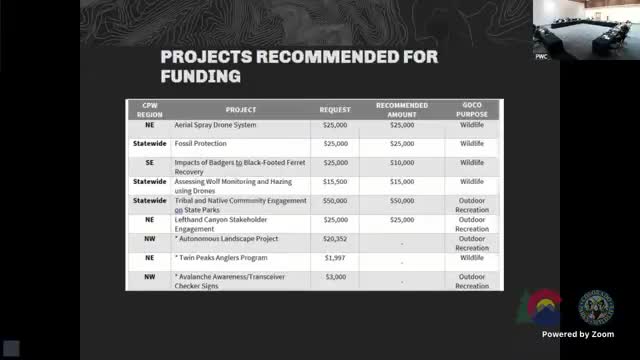GoCo Funds Drone Wildlife Management and Indigenous Engagement in Colorado's West Region
July 19, 2025 | Parks and Wildlife Commission, Governor's Boards and Commissions, Organizations, Executive, Colorado
Thanks to Scribe from Workplace AI , all articles about Colorado are free for you to enjoy throughout 2025!

This article was created by AI using a video recording of the meeting. It summarizes the key points discussed, but for full details and context, please refer to the video of the full meeting. Link to Full Meeting
One of the standout discussions centered around the integration of drone technology in wildlife management. The commission revealed ongoing funding for unique projects utilizing drones, which have shown promise in monitoring wildlife and managing habitats. This innovative approach is expected to yield valuable insights as staff continue to explore its potential applications.
Additionally, the commission allocated funds to the Colorado Natural Areas Program, specifically targeting the protection of fossil sites threatened by erosion. This initiative underscores a commitment to preserving Colorado's rich natural heritage for future generations.
Research efforts in the southeastern part of the state were also a focal point, with funding directed towards studying badgers and ferrets. The introduction of radio collars for ferrets marks a pioneering step in wildlife research, aiming to enhance understanding of these species and their habitats.
A significant highlight was the announcement of a $50,000 grant dedicated to fostering native and indigenous engagement in state parks. This initiative aligns with the commission's new strategic plan and represents a commitment to inclusivity and collaboration with local communities.
Katie Smith, the program officer for Great Outdoors Colorado's West Region, took the floor to discuss the unique challenges and opportunities facing the area. With a population of approximately 320,700 across seven counties, the region is rich in natural resources but grapples with balancing conservation and recreation. Increasing visitation to public lands has strained ecosystems and local infrastructure, prompting calls for sustainable recreation planning and visitor education.
Smith emphasized the impact of prolonged drought and water scarcity, which have led to the designation of several counties as natural disaster zones. The ongoing threat of wildfires further complicates the landscape, yet the region remains a beacon for outdoor enthusiasts, offering world-class hiking, biking, and wildlife viewing opportunities.
As the meeting concluded, the commission's discussions painted a picture of a state committed to innovative wildlife management and sustainable outdoor recreation. With a focus on collaboration and community engagement, Colorado Parks and Wildlife is poised to navigate the challenges ahead while celebrating the natural beauty that defines the state.
Converted from Colorado Parks and Wildlife Commission Meeting - Day 2 meeting on July 19, 2025
Link to Full Meeting
Comments
View full meeting
This article is based on a recent meeting—watch the full video and explore the complete transcript for deeper insights into the discussion.
View full meeting